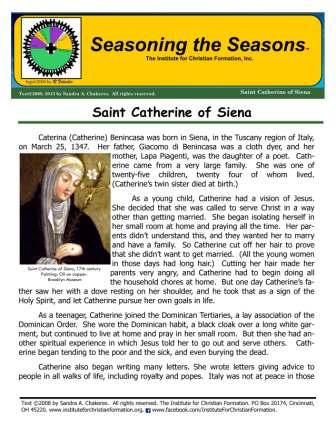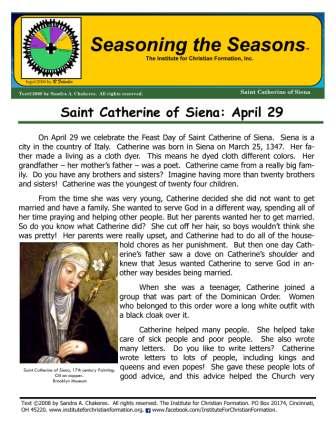The Institute for Christian Formation
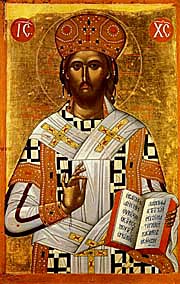
Saint Catherine of Siena,
Virgin and Doctor of the Church
Feast Day (Memorial): April 29
Caterina (Catherine) Benincasa was born in Siena, in the Tuscany region of Italy, on March 25, 1347. Her father, Giacomo di Benincasa was a cloth dyer, and her mother, Lapa Piagenti, was the daughter of a poet. Catherine came from a very large family. She was one of twenty-five children, twenty four of whom lived. (Catherine’s twin sister died at birth.)
As a young child, Catherine had a vision of Jesus. She decided that she was called to serve Christ in a way other than getting married. She began isolating herself in her small room at home and praying all the time. Her parents didn’t understand, and they wanted her to marry and have a family. So Catherine cut off her hair to prove that she didn’t want to get married. (All the young women in those days had long hair.) Cutting her hair made her parents very angry, and Catherine had to begin doing all the household chores at
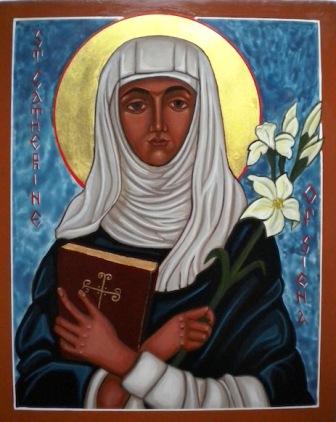
Saint Catherine of Siena
Iconographer: Liette McManaman
21st Century
Used with permission
home. But one day Catherine’s father saw her with a dove resting on her shoulder, and he took that as a sign of the Holy Spirit, and let Catherine pursue her own goals in life.
As a teenager, Catherine joined the Dominican Tertiaries, a lay association of the Dominican Order. She wore the Dominican habit, a black cloak over a long white garment, but continued to live at home and pray in her small room. But then she had another spiritual experience in which Jesus told her to go out and serve others. Catherine began tending to the poor and the sick, and even burying the dead.
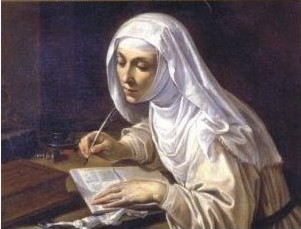
Saint Catherine of Siena Writing
Artist: Rutilio Manetti (1571–1639)
Catherine also began composing many letters. She sent letters giving advice to people in all walks of life, including royalty and popes. Italy was not at peace in those days. There was war between Florence and the Holy See, and unrest in all of the Papal States. In Catherine’s correspondence, she pleaded for peace.
Have you ever heard of the Avignon Papacy? There was a period of time when the Pope had moved the papacy from Rome to Avignon, France. This was the case
during Catherine’s lifetime. Catherine began a long period of correspondence with Pope Gregory XI (pope from 1370-1378). You can read one of Saint Catherine’s letters to Pope Gregory here. In 1376, Catherine even went to Avignon as an ambassador for Florence, but was unsuccessful in her quest for peace. However, she made a tremendous impression on Pope Gregory. She wanted Gregory to reform the clergy and move the papacy back to Rome. Eventually, in January of 1377, Pope Gregory XI did move the papacy back to Rome. Gregory died soon after this.
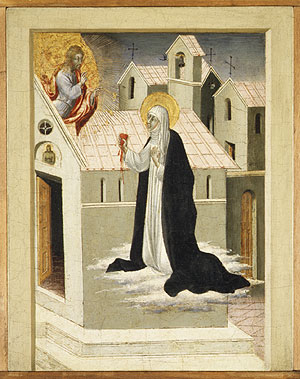
Saint Catherine of Siena
exchanging her heart with Christ.
Giovanni di Paolo
(1403–1482)
Catherine lived in Rome, where she worked for the reformation of the Church and continued to serve the poor and sick, until her own death from a painful illness on April 29, 1380. She was thirty-three years old when she died. The people of Siena wanted Catherine’s body returned home, but the people of Rome wanted to keep her body there for burial. Somehow Catherine’s head was returned to Siena, while the rest of her body was buried in a basilica in Rome. There is a legend that says that since the people of Siena knew they could not get Catherine’s entire body past the Roman guards, they took only her head. The legend says that when the Roman Guards stopped the people and looked in the bag where Catherine’s head was placed, they saw only rose petals. But when the people got back to Siena, the legend says that Catherine’s
head reappeared. To this day, Catherine’s head is entombed in the basilica of San Dominico, very near Catherine’s home in Siena, Italy. Catherine is an “incorruptible” which means that her body miraculously did not decompose after death.
In 1461, Pope Pius II canonized Saint Catherine of Siena. In 1970, Pope Paul VI gave Saint Catherine the title of “Doctor of the Church.” There are only four women who have been given this title. We celebrate the Feast of Saint Catherine of Siena on April 29, the date she died. Saint Catherine is the patron saint of many people, causes, and places. These include nurses, sick people, the city of Siena, the country of Italy, and in 1999 Pope John Paul II proclaimed Catherine of Siena as one of the co-patron saints of the entire continent of Europe! You can read Pope John Paul II’s Apostolic Letter containing this proclamation here.

Because of her various spiritual visions, Saint Catherine is considered a great mystic. She is also remembered as a great spiritual writer. Nearly 400 of her letters have survived, and she composed other works, as well, including The Dialogue. You can read the complete text of The Dialogue here. In art, Catherine is usually depicted wearing the white habit and black cloak of Dominican Order. Art might also include a lily, which is a symbol of purity, and/or a book, representing her many writings.
Saint Catherine of Siena is a wonderful Christian role model, and her life illustrates the impact one person’s actions can have in the Church and in the world.
Below, you can download our ICF Saint Catherine of Siena bulletins and handouts, which include suggested activities.
Click on the image above to download our ICF bulletin on Saint Catherine of Siena.
Click on the image above to download our ICF bulletin on Saint Catherine of Siena for younger children.
Click on the image above to download our ICF handout on suggested activities to celebrate Saint Catherine.
Click on the image above to download our ICF Saint Catherine of Siena "fill in the blank" activity sheet.
You can find a Saint Catherine of Siena litany posted online. You can read the text of a talk Pope Benedict XVI gave on November 24, 2010 about Saint Catherine of Siena here.
Celebrate Saint Catherine of Siena’s feast day with a traditional pastry from Siena. Cavallucci di Siena is a type of biscuit/cookie/biscotti which has been baked and given as gifts in Siena since the 16th century. You can find a recipe, and even a video demonstrating how to prepare these cookies, here. And here is another recipe for these cookies. Another traditional treat from Siena is a cake, Panforte di Siena, which can be traced back to the 12th century, so Catherine, herself, may have been familiar with this cake! Here is a recipe for this cake. You could even prepare one of these recipes as a feast day treat for any Catherine’s and Cathy’s in your life! If you are not a baker, a nice feast day gift might be a blank book where Catherine’s namesakes can record their own spiritual thoughts! Saint Catherine of Siena, pray for us!
Follow us on Facebook to keep up to date with our news and newest resources!
